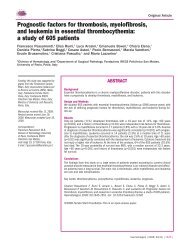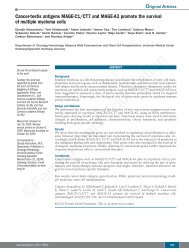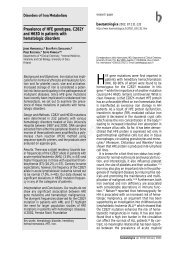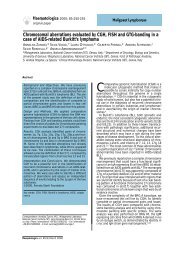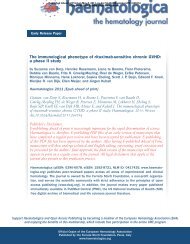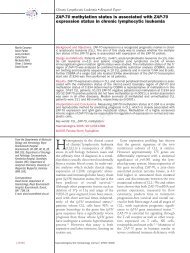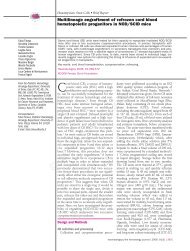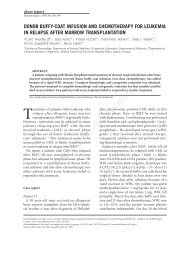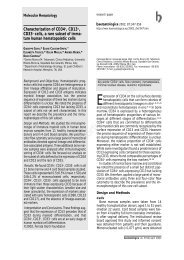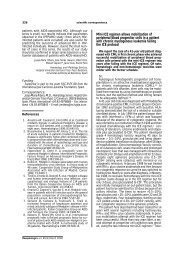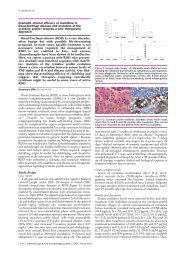Missense mutation in a patient with X-linked dyskeratosis congenita
Missense mutation in a patient with X-linked dyskeratosis congenita
Missense mutation in a patient with X-linked dyskeratosis congenita
You also want an ePaper? Increase the reach of your titles
YUMPU automatically turns print PDFs into web optimized ePapers that Google loves.
D.M. Kraemer et al.<br />
<strong>Missense</strong> <strong>mutation</strong> <strong>in</strong> a <strong>patient</strong> <strong>with</strong> X-l<strong>in</strong>ked<br />
<strong>dyskeratosis</strong> <strong>congenita</strong><br />
We report the case of a 40-year-old male <strong>patient</strong><br />
<strong>with</strong> <strong>dyskeratosis</strong> <strong>congenita</strong> (DKC). Sequenc<strong>in</strong>g of<br />
the DKC1 gene revealed an <strong>in</strong>herited missense<br />
<strong>mutation</strong> <strong>in</strong> base 1050 (GC), chang<strong>in</strong>g methion<strong>in</strong>e<br />
to isoleuc<strong>in</strong>e. This is the third description of a<br />
<strong>mutation</strong> <strong>in</strong> codon 350 (exon 11), chang<strong>in</strong>g a very<br />
well conserved am<strong>in</strong>o acid <strong>in</strong> the pseudourid<strong>in</strong>e<br />
synthase (PUA) doma<strong>in</strong> of dysker<strong>in</strong>.<br />
Haematologica 2007; 88:(4)e44-e45<br />
Dyskeratosis <strong>congenita</strong> is a rare <strong>in</strong>herited disease characterized<br />
by the triad of abnormal sk<strong>in</strong> pigmentation,<br />
nail dystrophy and mucosal leucoplakia. Further symptoms<br />
of DKC <strong>in</strong>clude gastro<strong>in</strong>test<strong>in</strong>al, genitour<strong>in</strong>ary,<br />
neurological, dental, ophthalmic, pulmonary and skeletal<br />
abnormalities. A major cause of death is bone marrow<br />
failure 1 . S<strong>in</strong>ce the disease affects rapidly divid<strong>in</strong>g somatic<br />
tissues <strong>in</strong> the adult, it is characterized by features of a<br />
premature age<strong>in</strong>g syndrome 2 .<br />
The ma<strong>in</strong>ly X-chromosomal (Xq28) <strong>in</strong>herited disease<br />
is caused by <strong>mutation</strong>s of the DKC1 gene, which codes<br />
for dysker<strong>in</strong>. The prote<strong>in</strong> of 514 am<strong>in</strong>o acids is highly<br />
conserved and homologous to rat Nap57 and<br />
Saccharomyces cerevisae Cbf5p 3 . Dysker<strong>in</strong> is the<br />
pseudourid<strong>in</strong>e synthase component of the box H/ACA<br />
small nucleolar RNAs 4 and appears to play a role <strong>in</strong><br />
pseudourid<strong>in</strong>ation of rRNA 4, 5 . In humans, dysker<strong>in</strong> is<br />
functionally associated <strong>with</strong> the RNA component of the<br />
telomerase complex 4 . Patients <strong>with</strong> DKC show shorten<strong>in</strong>g<br />
of their telomeres <strong>in</strong> different organs 6, 7 . S<strong>in</strong>ce telomere<br />
shorten<strong>in</strong>g may contribute to the physiological<br />
decl<strong>in</strong>e that occurs <strong>with</strong> age<strong>in</strong>g, symptoms of DKC may<br />
be expla<strong>in</strong>ed by this telomere shorten<strong>in</strong>g 2 . The precise<br />
function of dysker<strong>in</strong> <strong>with</strong> respect to telomerase activity<br />
is still unknown 8 .<br />
Several <strong>mutation</strong>s have been described, caus<strong>in</strong>g s<strong>in</strong>gle<br />
am<strong>in</strong>o acid substitutions <strong>in</strong> the encoded prote<strong>in</strong>,<br />
dysker<strong>in</strong>. The most frequent <strong>mutation</strong> causes the substitution<br />
of alan<strong>in</strong>e to val<strong>in</strong>e at position 353 (A353V) 1, 9 .<br />
We describe a 40-year-old male who was referred for<br />
evaluation of thrombocytopenia, which had first been<br />
observed three years earlier. His family history was unremarkable.<br />
On physical exam<strong>in</strong>ation, the <strong>patient</strong><br />
appeared older than his stated age. Reticulated and<br />
speckled hyper- and hypopigmentation of the sk<strong>in</strong> was<br />
seen especially at the upper trunk. His hair was sparse<br />
and most f<strong>in</strong>ger- and toenails were miss<strong>in</strong>g or dystrophic.<br />
Exam<strong>in</strong>ation of the oropharynx revealed buccal and<br />
tongue leucoplakias and loss of almost all teeth.<br />
Furthermore atresia of lacrimal duct was noted.<br />
Laboratory <strong>in</strong>vestigations showed tricytopenia <strong>with</strong><br />
leukopenia (2.9 x 10 9 /l), anaemia (haemoglob<strong>in</strong> 11.0<br />
g/dl), thrombopenia (75 x 10 9 /l). Differential blood count<br />
revealed 2% myelocytes, 2% band forms, 58% neutrophils,<br />
2% eos<strong>in</strong>ophils, 20% lymphocytes and 14%<br />
monocytes. A bone marrow biopsy showed reduction of<br />
haematopoiesis. No chromosomal aberrations were<br />
detected. We diagnosed <strong>dyskeratosis</strong> <strong>congenita</strong>. To show<br />
the X-chromosomal trait and to confirm diagnosis we<br />
sequenced the DKC1 gene.<br />
Genomic DNA was extracted from peripheral blood of<br />
the <strong>patient</strong>, the <strong>patient</strong>s mother and an unrelated female<br />
control us<strong>in</strong>g standard procedures. All fifteen exons and<br />
the flank<strong>in</strong>g <strong>in</strong>tronic regions constitut<strong>in</strong>g the cod<strong>in</strong>g<br />
region of human DKC1 gene were amplified <strong>with</strong> 30<br />
| 44 | haematologica/the hematology journal | 2003; 88(onl<strong>in</strong>e)<br />
sense- and antisense primers as described 9 . All PCR<br />
products were subcloned (Topo TA clon<strong>in</strong>g kit,<br />
Invitrogen, Gron<strong>in</strong>gen, Netherlands) and sequenced<br />
from 3- and 5-site us<strong>in</strong>g M13-reverse and T7-promoter<br />
primers. Sequenc<strong>in</strong>g was performed us<strong>in</strong>g the ABI<br />
PRISM genetic analyser (PE Applied Biosystems, Foster<br />
City, CA, USA). PCR products of exon 11 were amplified<br />
by at least three different polymerase cha<strong>in</strong> reactions and<br />
beside subclon<strong>in</strong>g PCR products were directly sequenced<br />
us<strong>in</strong>g sense and antisense amplification primers.<br />
Gene analysis revealed a missense <strong>mutation</strong> <strong>in</strong> exon 11<br />
(1050 GC) <strong>in</strong> <strong>patient</strong> DNA result<strong>in</strong>g <strong>in</strong> the substitution of<br />
methion<strong>in</strong>e to isoleuc<strong>in</strong>e at position 350 (M350I).<br />
Sequence analysis of the mother showed a heterozygous<br />
<strong>mutation</strong> at the same position. The female control<br />
showed no <strong>mutation</strong> (Figure1.).<br />
To our knowledge, this is the first description of a GC<br />
<strong>mutation</strong> <strong>in</strong> base pair 1050 of the DKC1 gene. Two other<br />
missense <strong>mutation</strong>s <strong>in</strong> codon 350 (1050 GA and 1049<br />
TC) have already been analysed and published 9 . The<br />
<strong>mutation</strong>s lead to an exchange of the very well conserved<br />
am<strong>in</strong>o acid methion<strong>in</strong>e at this position (Figure 2.).<br />
Beside the common A353V <strong>mutation</strong>, <strong>mutation</strong>s <strong>in</strong><br />
codon 350 appear to be the second most frequent <strong>in</strong><br />
DKC. Both of these <strong>mutation</strong>s of exon 11 localize to the<br />
PUA doma<strong>in</strong> (PseudoUrid<strong>in</strong>e synthase and Archaeos<strong>in</strong>especific<br />
transglycosylase) of the prote<strong>in</strong> 1 . <strong>Missense</strong><br />
<strong>mutation</strong>s <strong>in</strong> this doma<strong>in</strong> may affect the pseudourid<strong>in</strong>e<br />
synthase function of dysker<strong>in</strong> which f<strong>in</strong>ally results <strong>in</strong><br />
Figure 1. Sequence of PCR-products. The asterisks <strong>in</strong>dicate the<br />
position of the mutated base (1050) <strong>in</strong> a female control (a), the<br />
<strong>patient</strong>s mother (b) and the <strong>patient</strong> (c).<br />
Figure 2. Prosite analysis of PUA-doma<strong>in</strong> (PS50890). Am<strong>in</strong>oacid<br />
350, methion<strong>in</strong>e, (gray box) is very well conserved <strong>in</strong> different<br />
species (from top to bottom: Aspergillus fumigatus, Candida albicans,<br />
Emericella nidulans, Kluyveromyces lactis,<br />
Schizosaccaromyces pombe, Saccharomyces cerevisiae, Homo<br />
sapiens and Rattus norvegicus).
DKC. These data are <strong>in</strong> agreement <strong>with</strong> recent data of<br />
hypomorphic Dkc1 mutant mice, which were impaired<br />
<strong>in</strong> ribosomal RNA pseudouridylation before the onset of<br />
DKC 10 .<br />
D.M. Kraemer; M. Goebeler<br />
Correspondence: Dr. med. Doris M. Kraemer, Mediz<strong>in</strong>ische<br />
Polikl<strong>in</strong>ik Kl<strong>in</strong>ikstr. 8 97070 Würzburg Germany. Phone: (49)-<br />
931-201-70030 Fax: (49)-931-201-70730<br />
Key words: <strong>dyskeratosis</strong> <strong>congenita</strong>- missense <strong>mutation</strong>- PUA<br />
doma<strong>in</strong><br />
References<br />
1. Dokal I. Dyskeratosis <strong>congenita</strong> <strong>in</strong> all its forms. Br J Haematol<br />
2000; 110:768-79.<br />
2. Marc<strong>in</strong>iak RA, Johnson FB, Guarente L. Dyskeratosis <strong>congenita</strong>,<br />
telomeres and human age<strong>in</strong>g. Trends Genet 2000; 16:193-<br />
5.<br />
3. Heiss NS, Knight SW, Vulliamy TJ, Klauck SM, Wiemann S,<br />
Mason PJ, et al. X-l<strong>in</strong>ked <strong>dyskeratosis</strong> <strong>congenita</strong> is caused by<br />
haematologica onl<strong>in</strong>e 2003<br />
<strong>mutation</strong>s <strong>in</strong> a highly conserved gene <strong>with</strong> putative nucleolar<br />
functions. Nat Genet 1998; 19:32-8.<br />
4. Mitchell JR, Cheng J, Coll<strong>in</strong>s K. A box H/ACA small nucleolar<br />
RNA-like doma<strong>in</strong> at the human telomerase RNA 3' end. Mol<br />
Cell Biol 1999; 19:567-76.<br />
5. Wang C, Query CC, Meier UT. Immunopurified small nucleolar<br />
ribonucleoprote<strong>in</strong> particles pseudouridylate rRNA <strong>in</strong>dependently<br />
of their association <strong>with</strong> phosphorylated Nopp140.<br />
Mol Cell Biol 2002; 22:8457-66.<br />
6. Mitchell JR, Wood E, Coll<strong>in</strong>s K. A telomerase component is<br />
defective <strong>in</strong> the human disease <strong>dyskeratosis</strong> <strong>congenita</strong>. Nature<br />
1999; 402:551-5.<br />
7. Vulliamy TJ, Knight SW, Mason PJ, Dokal I. Very short telomeres<br />
<strong>in</strong> the peripheral blood of <strong>patient</strong>s <strong>with</strong> X-l<strong>in</strong>ked and<br />
autosomal <strong>dyskeratosis</strong> <strong>congenita</strong>. Blood Cells Mol Dis 2001;<br />
27:353-7.<br />
8. Coll<strong>in</strong>s K, Mitchell JR. Telomerase <strong>in</strong> the human organism.<br />
Oncogene. 2002; 21:564-79.<br />
9. Knight SW, Heiss NS, Vulliamy TJ, Greschner S, Stavrides G,<br />
Pai GS, Lestr<strong>in</strong>gant G, Varma N, Mason PJ, Dokal I, Poustka A.<br />
X-l<strong>in</strong>ked <strong>dyskeratosis</strong> <strong>congenita</strong> is predom<strong>in</strong>antly caused by<br />
missense <strong>mutation</strong>s <strong>in</strong> the DKC1 gene. Am J Hum Genet.<br />
1999; 65:50-8.<br />
10. Ruggero D, Grisendi S, Piazza F, Rego E, Mari F, Rao PH,<br />
Cordon-Cardo C, Pandolfi PP. Dyskeratosis <strong>congenita</strong> and<br />
cancer <strong>in</strong> mice deficient <strong>in</strong> ribosomal RNA modification.<br />
Science. 2003; 299:259-62.<br />
haematologica/the hematology journal | 2003; 88(onl<strong>in</strong>e) | 45 |



